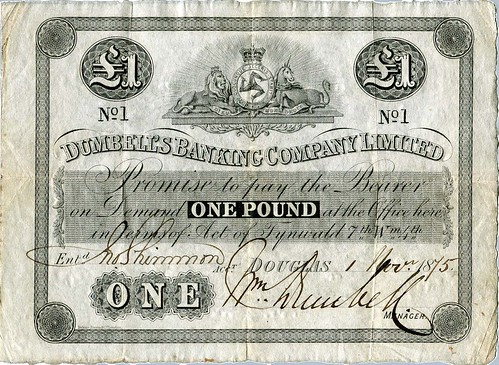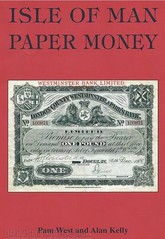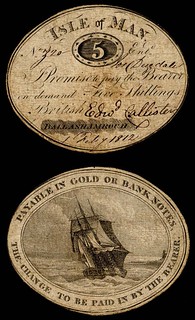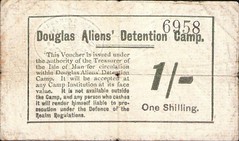
PREV ARTICLE
NEXT ARTICLE
FULL ISSUE
PREV FULL ISSUE
BOOK REVIEW: ISLE OF MAN PAPER MONEY
A new book on the paper money of the Isle of Man has been written by Pam West and Alan Kelly. For background, Pam kindly forwarded me a
copy of a review by Jonathan Callaway. Here it is, along with some images of notes cataloged in the book. Thanks! -Editor
Pam West and Alan Kelly have reviewed and catalogued every example of paper money ever issued on the Isle of Man. There have been earlier catalogues but none is as comprehensive in its coverage and this is the first one to provide a complete pricing guide. The book opens with an extensive introduction chapter contributed by Jonathan Callaway covering not only the historical background but also a brief outline of the currency history of the Island. The first section of the catalogue proper covers the many early 19th century card money issues which were abolished in 1817. Many new discoveries have been listed and many new images of these rare pieces are included. The authors have trawled not only institutional collections on the Island and elsewhere but also gained access to the leading private collections.
The complex history of Dumbell’s Bank comes next, again with illustrations of a number of very rare notes and a fully detailed listing of the bank’s issues. This bank failed in 1900 and creditors got just 12s 7½d (63p) in the pound although the note holders were paid out in full – hence fully issued notes are rare today. 
The final note issuing bank to be established on the Isle of Man was the Isle of Man Joint Stock Banking Company Limited, in November 1865. The bank’s issues are covered with the same degree of detail as previous issuers but there is more – when Waterlow & Sons Ltd took over the printing contract in 1927 they used the positional plate letters seen on all the notes they produced. Here the book sets out the plate letter sequences in remarkably full detail. A total of 530,000 £1 notes were printed by Waterlows with one master plate for each side of the note, each with four impressions on it. Each impression was given its own plate letter and the book lists in full the complex pattern of plate letters, prefixes and dates. The original master plates were re-engraved in 1952 and each of the four impressions given a new plate letter. On top of this there were frequent signature changes and again these are set out in complete detail. For specialist collectors this is as good as it gets! Waterlow also printed 7,200 £5 notes for the bank between 1927 and 1960. Such a tiny print run required just one plate for each side but there are still five date and signature varieties to collect despite the fact that 2,600 of these notes were never issued. In 1896 saw the first of the English banks arrive to offer the local banks serious competition. Four English banks eventually issued their own notes. These issues are popular with many collectors due to the fact that they are the only banknotes any of these banks ever issued; they were unable to issue notes in England itself due to a different legislative environment and the dominance of the Bank of England. Once again the book does not let collectors down and provides every level of detail on type, variety and signature changes through to 1961 when the Tynwald withdrew the right for commercial banks to issue their own notes.
The final third of the book focuses on the issues of the Isle of Man Government – a much loved and widely collected series which has been running for over 50 years and still going strong. All these beautiful notes carry a portrait of H.M. Queen Elizabeth II and the many varieties and signature changes are naturally covered in the full detail we have come to expect. Nearly every known proof, specimen and colour trial is illustrated and once again a lot of new information has been unearthed for collectors to enjoy. ‘Isle of Man Paper Money’ covers well over 200 years of paper money history in its 412 pages. It achieves a level of detail few catalogues can aspire to and will stand for many years as the definitive guide to the Isle of Man’s paper currency issues. The book is beautifully produced and all illustrations are in full colour. This reviewer cannot recommend this book enough. It would grace the shelf of any paper money enthusiast and surely whet the appetite of anyone who has yet to start collecting these fascinating and lovely notes.
I couldn't think of much to add. I have a copy of the book, and was quite impressed. The color images throughout are marvelous, and I
was pleased to see the extensive section on internment camp notes. It's packed with information from the first page to the last. Nice
job! See the separate article later in this issue taken from Alan Kelly's Foreword. -Editor
Pam West writes: The book is available at £24 plus post from our site – it is on the front page or in the Books section. I appreciate you are overseas and those reading will be from overseas, however, we treat each book order separately and seek the best posting option (giving as much choice as possible). We will have some copies for sale at the Memphis show. People can pre-order with me. For more information, or to order, see:

Wayne Homren, Editor The Numismatic Bibliomania Society is a non-profit organization promoting numismatic literature. See our web site at coinbooks.org. To submit items for publication in The E-Sylum, write to the Editor at this address: whomren@gmail.com To subscribe go to: https://my.binhost.com/lists/listinfo/esylum All Rights Reserved. NBS Home Page Contact the NBS webmaster 
|


